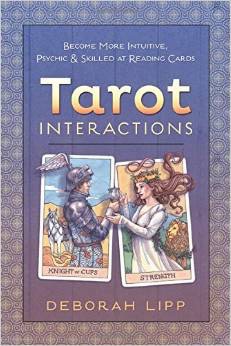Review by Diane Wilkes

Tarot Interactions
Become More Intuitive, Psychic and Skilled at Reading Cards
By Deborah Lipp
Published by Llewellyn Worldwide
www.llewellyn.com
ISBN: 978-0-73874-520-6
Retail: U.S. $16.99
Fledgling tarot readers often want to understand how to put the cards together in a meaningful way. Pagan author and former wife of Druidic authority Isaac Bonewits, Deborah Lipp, has written an intermediate book on the subject, Tarot Interactions, which has as its subtitle “Become More Intuitive, Psychic and Skilled at Reading Cards.” The book blooms with examples and exercises of how to do just that.
In the introduction, Lipp makes it clear that the book is not for beginning readers. She then covers the three “tools” she believes are necessary for developing any psychic skill: meditation, self-knowledge and trust (in the psychic self and synchronicity). She provides additional methods for encouraging an entity she frequently refers to as the “psychic child.” She then addresses how tarot specifically draws on and facilitates those tools. This seems a perfect beginning.
I am less confident that the second chapter should be placed where it is, as it introduces other disciplines that can be combined with tarot, such as Kaballah and astrology. Many tarot readers have little to no knowledge of either discipline, so this chapter seems extraneous and digressive. Because the exercises are necessarily simplistic, the exercises are almost a form of name-dropping, especially since no interactive techniques have yet been touched upon. After reading the book, I think this chapter would have been better placed as the final one. I remark on this primarily because, in a book as clear and organized as this one, the placement of this chapter is a bit jarring.
Her next few chapters are the meatiest, wherein she teaches readers to observe and apply meaning to particular patterns within the cards, such as a predomination of Majors, Minors, and or Court Cards, as well as suit and number. She then broaches the subject of spreads and spread positions, showing step-by-step the dance between cards and their position in a layout. The exercises are excellent and include the reader devising his or her own spread with specific, individual purpose. In the following chapter, she explores the benefits of integrating facial/physical directions of the card images in combination to add another layer of interpretation. Her examples are vivid and easy to follow. I especially like her use of paintings to determine flow of movement, which skill can be transferred to understanding the flow of movement in a tarot layout.
The author then introduces “the grammar of tarot,” which provides instructions for constructing a tarot narrative that a querent will easily understand and retain. Storytelling techniques and structure are also addressed. This chapter will help any reader develop better communication skills. The focus then shifts to interacting with querents, whom she breaks down into four categories: self, friends and family, known paying customers, and strangers. Lipp proposes methods to create connection and urges readers not to be afraid to ask questions, but not go on “fishing expeditions.” She acknowledges that it takes time and experience to balance the fine line between exuding confidence in one’s skills and soliciting information, which is another example of the honesty and experience that makes her such a reliable narrator.
The final chapter allows for play and experimentation in one’s interactions with the cards. Lipp offers examples of innovative ways to use the cards, as well as some experimental techniques. Lipp’s guiding tarot light is Eden Gray, and she stresses Gray’s methodology on upright cards meaning “yes” (with reversals always corresponding to “no”). Because I have not found that particular technique to be accurate in my own readings—and, in fact, I find it disempowering—I simply choose to ignore that aspect when exploring Lipp’s activities for myself.
Tarot Interactions includes three appendices—the first offers card meanings for all 78 cards, the second, card/spread patterns and their meanings (which is also covered in an earlier chapter). The third appendix contains the author’s book recommendations.
Lipp’s specific tarot reading beliefs and habits are made clear to the reader. The author has a definite bias towards reversed cards, for example, seeing them as uniformly negative. One technique Lipp refers to as “dropping cards” is better known to me as using clarifier cards. While the author does not impose her own preferences on the reader, she stresses that her own inclination is not to use a lot of cards. Oddly, though, she suggests using a past-present-future spread after completing a Celtic Cross reading as “the cherry on top of the spread.” This seems to me more like gilding the lily. Either the three cards will merely reiterate the message of the Celtic Cross or they will contradict it, muddying the message-waters.
Lipp also seems to favor not knowing a querent’s specific question, as a way of allowing the psychic child within to respond untrammeled by specifics. Hence, in one reading example, the author is focusing her interpretation on career when the querent says that her question is, in fact, about fertility and childbearing. Lipp revisits the cards with that focus. This displays both the versatility of the tarot and emphasizes that the reader is in service to the querent, not the other way around.
All of the chapters include an array of questions that ensure the reader has understood the material, as well as exercises that introduce or reinforce particular skills. Often, they also demand that the reader explore his or her individual belief systems, inclinations, and reading style.
There are many beginning books on tarot and very few advanced ones. Fewer still are books for the mid-level tarot reader. It seems Bonewits had often urged Lipp to write a book on the tarot and she has finally done so. Gratitude to them both for adding an important, mid-level addition to the tarot oeuvre.